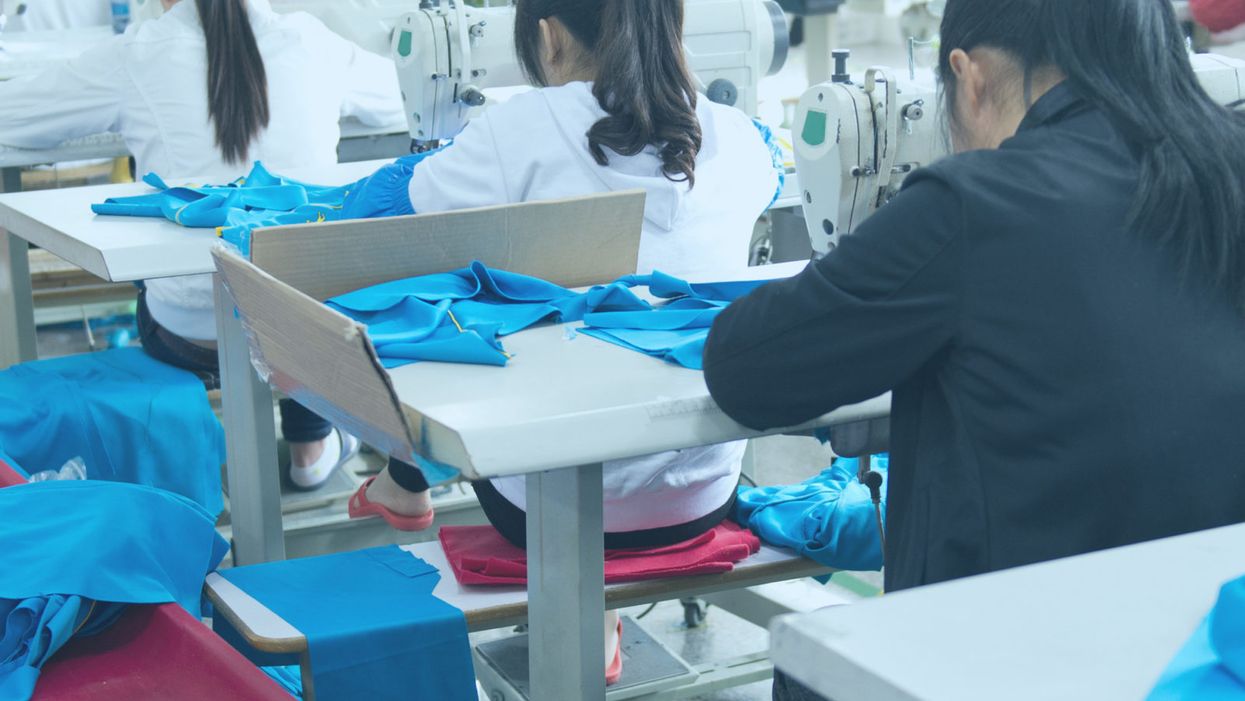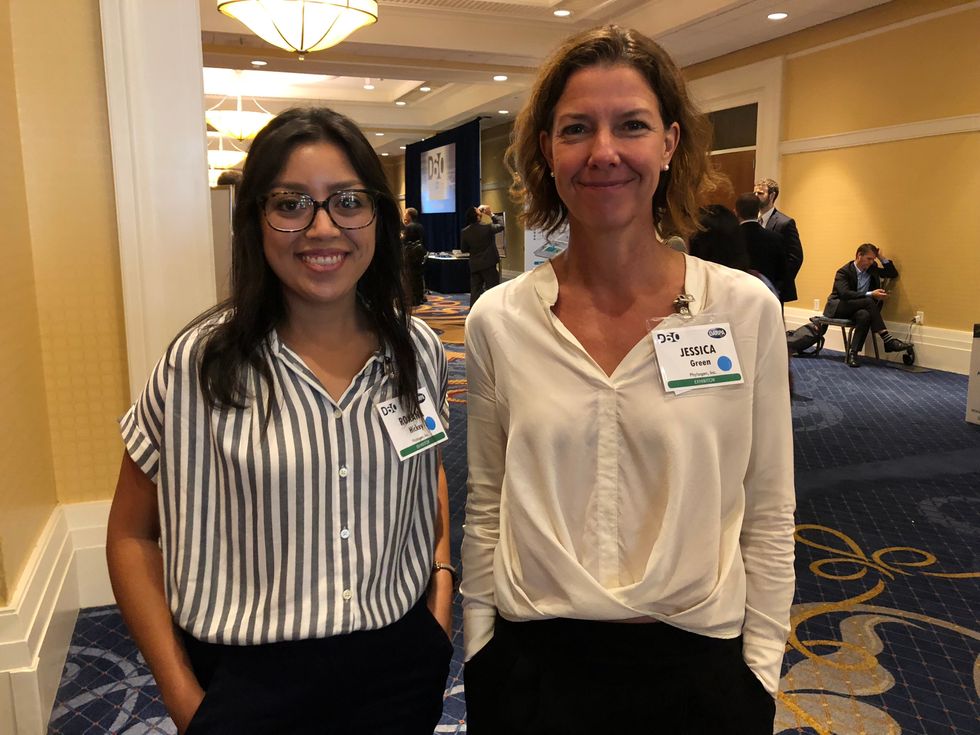This Startup Uses Dust to Fight Sweatshops
Kira Peikoff was the editor-in-chief of Leaps.org from 2017 to 2021. As a journalist, her work has appeared in The New York Times, Newsweek, Nautilus, Popular Mechanics, The New York Academy of Sciences, and other outlets. She is also the author of four suspense novels that explore controversial issues arising from scientific innovation: Living Proof, No Time to Die, Die Again Tomorrow, and Mother Knows Best. Peikoff holds a B.A. in Journalism from New York University and an M.S. in Bioethics from Columbia University. She lives in New Jersey with her husband and two young sons. Follow her on Twitter @KiraPeikoff.

Workers at an industrial textile factory.
"Dust thou art, and unto dust shalt thou return." Whoever wrote that famous line probably didn't realize that dust actually contains a secret weapon.
"We have developed the capability to turn dust into data that can be used to trace problems in the supply chain."
Far from being a collection of mere inanimate particles, dust is now recognized as a powerful tool filled with living sensors. Studying those sensors can reveal an object's location history, which can help brands fight unethical manufacturing.
"We have developed the capability to turn dust into data that can be used to trace problems in the supply chain," explains Jessica Green, the CEO of Phylagen, a San-Francisco-based company that she co-founded in 2014.
So how does the technology work?
Dust gathers everywhere—on our bodies, on objects—and that dust contains microbes like bacteria and viruses. Just as we humans have our own unique microbiomes, research has shown that physical locations have their own identifiable patterns of microbes as well. Visiting a place means you may pick up its microbial fingerprint in the dust that settles on you. The DNA of those microbes can later be sequenced in a lab and matched back to the place of origin.
"Your environment is constantly imprinted on you and vice versa," says Justin Gallivan, the director of the Biotechnology Office at DARPA, the research and defense arm of the Pentagon, which is funding Phylagen. "If we have a microbial map of the world," he posits, "can we infer an object's transit history?"
So far, Phylagen has shown that it's possible to identify where a ship came from based on the unique microbial populations it picked up at different naval ports. In another experiment, the sampling technology allowed researchers to determine where a person had walked within 1 kilometer in San Francisco, because of the microbes picked up by their shoes.
One application of this technology is to help companies that make products abroad. Such companies are very interested in determining exactly where their products are coming from, especially if foreign subcontractors are involved.
"In retail and apparel, often the facilities performing the subcontracting are not up to the same code that the brands require their suppliers to be, so there could be poor working conditions," says Roxana Hickey, a data scientist at Phylagen. "A supplier might use a subcontractor to save on the bottom line, but unethical practices are very damaging to the brand."
Before this technology was developed, brands sometimes faced a challenge figuring out what was going on in their supply chain. But now a product can be tested upon arrival in the States; its microbial signature can theoretically be analyzed and matched against a reference database to help determine if its DNA pattern matches that of the place where the product was purported to have been made.
Phylagen declined to elaborate further about how their process works, such as how they are building a database of reference samples, and how consistent a microbial population remains across a given location.
As the technology grows more robust, though, one could imagine numerous other applications, like in police work and forensics. But today, Phylagen is solely focused on helping commercial entities bring greater transparency to their operations so they can root out unauthorized subcontracting.
Then those unethical suppliers can – shall we say – bite the dust.
Kira Peikoff was the editor-in-chief of Leaps.org from 2017 to 2021. As a journalist, her work has appeared in The New York Times, Newsweek, Nautilus, Popular Mechanics, The New York Academy of Sciences, and other outlets. She is also the author of four suspense novels that explore controversial issues arising from scientific innovation: Living Proof, No Time to Die, Die Again Tomorrow, and Mother Knows Best. Peikoff holds a B.A. in Journalism from New York University and an M.S. in Bioethics from Columbia University. She lives in New Jersey with her husband and two young sons. Follow her on Twitter @KiraPeikoff.
Here's how one doctor overcame extraordinary odds to help create the birth control pill
Dr. Percy Julian had so many personal and professional obstacles throughout his life, it’s amazing he was able to accomplish anything at all. But this hidden figure not only overcame these incredible obstacles, he also laid the foundation for the creation of the birth control pill.
Julian’s first obstacle was growing up in the Jim Crow-era south in the early part of the twentieth century, where racial segregation kept many African-Americans out of schools, libraries, parks, restaurants, and more. Despite limited opportunities and education, Julian was accepted to DePauw University in Indiana, where he majored in chemistry. But in college, Julian encountered another obstacle: he wasn’t allowed to stay in DePauw’s student housing because of segregation. Julian found lodging in an off-campus boarding house that refused to serve him meals. To pay for his room, board, and food, Julian waited tables and fired furnaces while he studied chemistry full-time. Incredibly, he graduated in 1920 as valedictorian of his class.
After graduation, Julian landed a fellowship at Harvard University to study chemistry—but here, Julian ran into yet another obstacle. Harvard thought that white students would resent being taught by Julian, an African-American man, so they withdrew his teaching assistantship. Julian instead decided to complete his PhD at the University of Vienna in Austria. When he did, he became one of the first African Americans to ever receive a PhD in chemistry.
Julian received offers for professorships, fellowships, and jobs throughout the 1930s, due to his impressive qualifications—but these offers were almost always revoked when schools or potential employers found out Julian was black. In one instance, Julian was offered a job at the Institute of Paper Chemistory in Appleton, Wisconsin—but Appleton, like many cities in the United States at the time, was known as a “sundown town,” which meant that black people weren’t allowed to be there after dark. As a result, Julian lost the job.
During this time, Julian became an expert at synthesis, which is the process of turning one substance into another through a series of planned chemical reactions. Julian synthesized a plant compound called physostigmine, which would later become a treatment for an eye disease called glaucoma.
In 1936, Julian was finally able to land—and keep—a job at Glidden, and there he found a way to extract soybean protein. This was used to produce a fire-retardant foam used in fire extinguishers to smother oil and gasoline fires aboard ships and aircraft carriers, and it ended up saving the lives of thousands of soldiers during World War II.
At Glidden, Julian found a way to synthesize human sex hormones such as progesterone, estrogen, and testosterone, from plants. This was a hugely profitable discovery for his company—but it also meant that clinicians now had huge quantities of these hormones, making hormone therapy cheaper and easier to come by. His work also laid the foundation for the creation of hormonal birth control: Without the ability to synthesize these hormones, hormonal birth control would not exist.
Julian left Glidden in the 1950s and formed his own company, called Julian Laboratories, outside of Chicago, where he manufactured steroids and conducted his own research. The company turned profitable within a year, but even so Julian’s obstacles weren’t over. In 1950 and 1951, Julian’s home was firebombed and attacked with dynamite, with his family inside. Julian often had to sit out on the front porch of his home with a shotgun to protect his family from violence.
But despite years of racism and violence, Julian’s story has a happy ending. Julian’s family was eventually welcomed into the neighborhood and protected from future attacks (Julian’s daughter lives there to this day). Julian then became one of the country’s first black millionaires when he sold his company in the 1960s.
When Julian passed away at the age of 76, he had more than 130 chemical patents to his name and left behind a body of work that benefits people to this day.
Therapies for Healthy Aging with Dr. Alexandra Bause
My guest today is Dr. Alexandra Bause, a biologist who has dedicated her career to advancing health, medicine and healthier human lifespans. Dr. Bause co-founded a company called Apollo Health Ventures in 2017. Currently a venture partner at Apollo, she's immersed in the discoveries underway in Apollo’s Venture Lab while the company focuses on assembling a team of investors to support progress. Dr. Bause and Apollo Health Ventures say that biotech is at “an inflection point” and is set to become a driver of important change and economic value.
Previously, Dr. Bause worked at the Boston Consulting Group in its healthcare practice specializing in biopharma strategy, among other priorities
She did her PhD studies at Harvard Medical School focusing on molecular mechanisms that contribute to cellular aging, and she’s also a trained pharmacist
In the episode, we talk about the present and future of therapeutics that could increase people’s spans of health, the benefits of certain lifestyle practice, the best use of electronic wearables for these purposes, and much more.
Dr. Bause is at the forefront of developing interventions that target the aging process with the aim of ensuring that all of us can have healthier, more productive lifespans.



